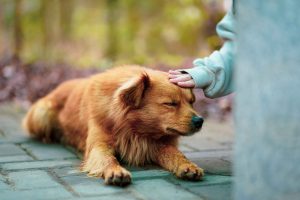Why Understanding Your Pet’s Body Language Matters
Although animals lack verbal communication skills their body movements reveal everything. People who own pets often fail to notice initial pain signals leading to severe health problems. Pet urgent care facilities become accessible when you understand the warning signs of illness. Protecting the well-being of your pet starts with identifying important signs for improved healthcare leading to their happiness and good health.
Signs of a Happy and Relaxed Pet
Every expression exhibited by an enjoyable pet will indicate their state of comfort. A content dog stands relaxed while wagging his tail and relaxing his ears with soft eyes and a playful frame of mind. A cat’s joyful state will display itself through blinking, purring noises along with an arched tail and gentle head strokes. Rabbits together with guinea pigs display relaxation through side resting followed by self-grooming while generating quiet pleasant noises.
At this time pets achieve their feeling of security and comfort. The relationship between pet owner and pet becomes stronger when pet care methods help maintain relaxed states in animals.
Warning Signs of Stress or Anxiety
The stress experienced by pets mirrors the stress experienced by human beings. Identifying these warning indicators early allows people to stop problems from becoming more severe. Multiple stress signs present themselves as panting accompanied by drooling and excessive licking in dogs and cats. Detectable signs of fear in pets include both flattened ears and tucked tail and a low-crouched body position. Animals show their stress by looking away from others while repeatedly blinking their eyes and tending to hide followed by shivering and swift changes toward aggression.
Constant showing of these symptoms indicates a need to identify environmental causes. Unusual noises combined with unfamiliar figures in addition to strange pets cause anxiety in animals. Creating a comforting environment along with rewarding them can minimize their anxiety.
Aggressive or Defensive Body Language
All pets including those known for being tender have aggressive tendencies that emerge when they experience fear. The signs from pets offer crucial information that helps protect both humans and animals. When feeling threatened a dog might produce low-pitched growls while showing teeth and becoming rigid with stiffen posture plus elevated hackles and fixed staring. The aggression signs in cats include dilated pupils combined with a swishing tail followed by an arched back and hissing noises. Rabbits along with other small pets tend to express aggression by producing loud teeth chattering combined with lunging and kicking movements.
Keep away from pets who display aggression until they become relaxed. It is important to stay collected and let the pet find their own resting place. When aggressive behavior persists it becomes important to contact a veterinarian or pet behaviorist.
How Different Pets Communicate
Dogs: Beyond the Wagging Tail
Although dogs wag their tails often no one should automatically conclude they feel joyful. A dog’s tail movement speed and direction creates an expanded description about its emotional state. A wide wagging motion fast enough shows happy interest in others whereas a slow wag shows a mix of caution and uncertain behavior from a dog. The tail position can reveal whether a dog is alert and dominant through high stiff movement but fear and submission appear when the tail is tucked low.
People who examine how a dog’s entire body positions can identify the specific message that a wagging tail expresses.
Cats: Subtle Yet Expressive
Cats convey messages through all body parts though specific information emerges from tail and ear movements. An upright tail combined with a curled position indicates both happiness and confidence in the feline. Fear together with anger can be detected through the condition of their tail as it becomes puffy. Turned-back ears together with flattened ears indicate aggressive behavior in felines. The expression of trust and affection will display itself through slow blinking movements.
Small Pets: Reading the Tiny Signals
The communication signals of rabbits along with guinea pigs together with small animals have particular ways of expressing themselves. Satisfied rabbits produce soft tooth grinding but intense teeth chattering shows they are in distress. When a rabbit ascending into the air (binky) it signifies happiness within the animal’s body. Stress or illness are possible causes when pets avoid eating their food or hide it.
Key Signs Your Pet Needs Urgent Care

1. Sudden Changes in Behavior
When a normally happy pet starts to behave aggressively or withdraw from interactions it may indicate pain as a possible health problem. A pet requiring immediate pet urgent care will adopt hiding behaviors and display unexpected growls and avoid touch situations.
2. Changes in Eating and Drinking Habits
The development of either a significant decline in appetite or unusually high thirst thus indicates medical issues. Advanced pet care should be considered for pets that do not eat their food for longer than 24 hours.
3. Heavy Panting or Labored Breathing
The presence of rapid breathing while at rest indicates a serious problem. Seek immediate professional advanced pet care because your pet shows heavy breathing or continues to pant heavily.
4. Unusual Posture or Movement
A pet undergoes abnormal movement patterns and may limp while experiencing difficulty getting up. These signs indicate pain. A hunched back together with movement reluctance serves as major symptoms of your pet’s discomfort.
5. Frequent Shaking or Trembling
Pets generally shiver during cold weather but ongoing shaking suggests a medical or health problem. A qualified trip to a progressive pet care facility is needed when your pet displays such symptoms.
6. Excessive Grooming or Licking
The persistent licking of particular points of the body signifies either bodily discomfort or skin-related problems. Watch your pet while they lick their paws, belly or tail since obsessive behavior might indicate a wound or infection.
7. Vomiting or Diarrhea
Cancer’s signs normally include occasional digestive upset and you should seek attention for persistent vomiting or diarrhea. Seek emergency care from a pet urgent care facility in situations where symptoms persist for longer than 24 hours or where bloody discharge is present.
8. Unusual Eye or Ear Discharge
Eye redness and swelling together with increased tear production may show signs of infection. Head shaking combined with ear scratching on a regular basis points to potential ear conditions that require professional attention.
How Pet Urgent Care Can Save Lives
Acting quickly can prevent minor issues from escalating into life-threatening conditions. Emergency veterinary services are equipped to handle sudden illnesses, injuries, and infections. Seeking timely care ensures your pet receives advanced pet care, improving recovery chances.
Tips for Preventing Pet Health Emergencies

1. Regular Vet Checkups
The detection of health problems through scheduled visits to the veterinarian prevents health emergencies from occurring. Treatment results become more positive when healthcare providers detect conditions during early stages.
2. Maintain a Healthy Diet
The proper consumption of nutrients protects your immune system and avoids digestive symptoms. Pets must avoid receiving table scraps or toxic foods for their dietary consumption.
3. Keep Up with Vaccinations
Vaccination provides defense against diseases which otherwise might create emergency conditions. Ensure your pet receives current vaccinations from a doctor.
4. Pet-Proof Your Home
All dangerous materials including electrical cords and toxic plants and human medication need to stay in inaccessible areas. Such environmental hazards lead to toxicity problems that also create injuries.
5. Know Emergency Contacts
Save the contact details of an accessible pet urgent care center as a backup in case of emergencies. A person who knows their emergency destination can shorten response time when faced with danger.
When to Seek Advanced Pet Care
Several health issues demand targeted medical care which surpasses standard urgent care services. An advanced pet care facility remains your best choice for treating chronic illnesses together with severe injuries or unexplained symptoms. Specialized centers provide both diagnostic testing services and surgical procedures and intensive care services to patients.
Final Thoughts: Take Action Before It’s Too Late
Courthead signals from your pet help you identify potential issues which could prevent undeserved pain. Watchful observation of pet behaviors allows you to provide them with both timely and advanced healthcare services. Any changes that catch your attention should lead you directly to pet urgent care facilities for immediate treatment.